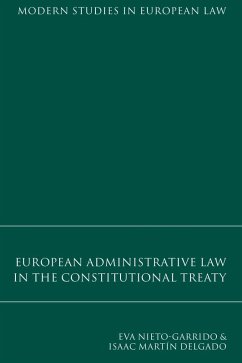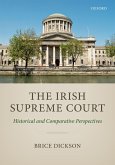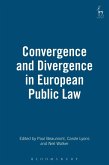Eva Nieto-Garrido, Isaac Martin Delgado
European Administrative Law in the Constitutional Treaty (eBook, PDF)
85,95 €
85,95 €
inkl. MwSt.
Sofort per Download lieferbar

43 °P sammeln
85,95 €
Als Download kaufen

85,95 €
inkl. MwSt.
Sofort per Download lieferbar

43 °P sammeln
Jetzt verschenken
Alle Infos zum eBook verschenken
85,95 €
inkl. MwSt.
Sofort per Download lieferbar
Alle Infos zum eBook verschenken

43 °P sammeln
Eva Nieto-Garrido, Isaac Martin Delgado
European Administrative Law in the Constitutional Treaty (eBook, PDF)
- Format: PDF
- Merkliste
- Auf die Merkliste
- Bewerten Bewerten
- Teilen
- Produkt teilen
- Produkterinnerung
- Produkterinnerung

Bitte loggen Sie sich zunächst in Ihr Kundenkonto ein oder registrieren Sie sich bei
bücher.de, um das eBook-Abo tolino select nutzen zu können.
Hier können Sie sich einloggen
Hier können Sie sich einloggen
Sie sind bereits eingeloggt. Klicken Sie auf 2. tolino select Abo, um fortzufahren.

Bitte loggen Sie sich zunächst in Ihr Kundenkonto ein oder registrieren Sie sich bei bücher.de, um das eBook-Abo tolino select nutzen zu können.
This book presents an integrated approach to general questions of European administrative law and offers some possible solutions to the problems which it poses, the Treaty establishing a Constitution for Europe being the point of reference. Under the Treaty general questions of administrative law are no longer addressed merely in a fragmented or incidental way but as a discipline that governs the exercise of sovereign powers by a supranational entity. This calls for a detailed examination of the fields which comprise European administrative law and the book therefore examines in some detail…mehr
- Geräte: PC
- mit Kopierschutz
- eBook Hilfe
- Größe: 1.19MB
Andere Kunden interessierten sich auch für
![The Irish Supreme Court (eBook, PDF) The Irish Supreme Court (eBook, PDF)]() Brice DicksonThe Irish Supreme Court (eBook, PDF)74,95 €
Brice DicksonThe Irish Supreme Court (eBook, PDF)74,95 €![Convergence and Divergence in European Public Law (eBook, PDF) Convergence and Divergence in European Public Law (eBook, PDF)]() Convergence and Divergence in European Public Law (eBook, PDF)80,95 €
Convergence and Divergence in European Public Law (eBook, PDF)80,95 €![Trade, Foreign Policy and Defence in EU Constitutional Law (eBook, PDF) Trade, Foreign Policy and Defence in EU Constitutional Law (eBook, PDF)]() Panos KoutrakosTrade, Foreign Policy and Defence in EU Constitutional Law (eBook, PDF)101,95 €
Panos KoutrakosTrade, Foreign Policy and Defence in EU Constitutional Law (eBook, PDF)101,95 €![Ethical Business Practice and Regulation (eBook, PDF) Ethical Business Practice and Regulation (eBook, PDF)]() Christopher HodgesEthical Business Practice and Regulation (eBook, PDF)29,95 €
Christopher HodgesEthical Business Practice and Regulation (eBook, PDF)29,95 €![Constitutional Change in the EU (eBook, PDF) Constitutional Change in the EU (eBook, PDF)]() Constitutional Change in the EU (eBook, PDF)80,95 €
Constitutional Change in the EU (eBook, PDF)80,95 €![Principles of Administrative Procedure in EC Law (eBook, PDF) Principles of Administrative Procedure in EC Law (eBook, PDF)]() Hanns Peter NehlPrinciples of Administrative Procedure in EC Law (eBook, PDF)80,95 €
Hanns Peter NehlPrinciples of Administrative Procedure in EC Law (eBook, PDF)80,95 €![Social Welfare and EU Law (eBook, PDF) Social Welfare and EU Law (eBook, PDF)]() Social Welfare and EU Law (eBook, PDF)71,95 €
Social Welfare and EU Law (eBook, PDF)71,95 €-
-
-
This book presents an integrated approach to general questions of European administrative law and offers some possible solutions to the problems which it poses, the Treaty establishing a Constitution for Europe being the point of reference. Under the Treaty general questions of administrative law are no longer addressed merely in a fragmented or incidental way but as a discipline that governs the exercise of sovereign powers by a supranational entity. This calls for a detailed examination of the fields which comprise European administrative law and the book therefore examines in some detail the key areas of rulemaking powers and normative instruments, the implications of the Charter of Fundamental Rights for European and national administrations, administrative procedure, and judicial protection within the European Union. The Foreword to the book is written by Professor Carol Harlow.
Produktdetails
- Produktdetails
- Verlag: Bloomsbury eBooks UK
- Seitenzahl: 210
- Erscheinungstermin: 9. Oktober 2007
- Englisch
- ISBN-13: 9781847313836
- Artikelnr.: 52847772
- Verlag: Bloomsbury eBooks UK
- Seitenzahl: 210
- Erscheinungstermin: 9. Oktober 2007
- Englisch
- ISBN-13: 9781847313836
- Artikelnr.: 52847772
- Herstellerkennzeichnung Die Herstellerinformationen sind derzeit nicht verfügbar.
Eva Nieto-Garrido is Profesora Titular of Administrative Law at the University of Castilla- La Mancha and clerk at the Spanish Constitutional Court.
1 Legislative Powers and Normative Instruments
I. INTRODUCTION
II. LEGISLATIVE POWERS AND NORMATIVE INSTRUMENTS UNDER THE CURRENT TREATIES
III. SIMPLIFICATION OF THE UNION'S NORMATIVE INSTRUMENTS AND THE
TRANSFORMATION OF EUROPEAN ADMINISTRATIVE LAW
IV. NEW NORMATIVE INSTRUMENTS UNDER THE CONSTITUTIONAL TREATY
1. Legislative Level: European Law and Framework Law
2. Delegated European Regulations
(a) On Requirements and Limits
(b) Mechanisms of Control
3. Implementing Acts
(a) Areas where Implementing Acts might be Used
(b) The Form and Mechanism for the Control of Implementing Acts
V. A THIRD TYPE OF EUROPEAN REGULATION
1. Competition Policy
2. State Aids
3. Economic and Monetary Policy
4. Area of Freedom, Security and Justice
VI. THE CHOICE BETWEEN PRIMARY LAW AND SECONDARY LAW: CONSEQUENCES
2 Implications of a Binding European Charter of Fundamental Rights for the
Individual Decisions Made by the European Public Administration
I. INTRODUCTION
II. THE RIGHT TO GOOD ADMINISTRATION
1. Origin of the Right to Good Administration in Community Law
2. Content of the Right to Good Administration
3. Implications of a Binding Right to Good Administration for the Community
Administration
III. THE RIGHT OF ACCESS TO DOCUMENTS
1. Origin of the Right of Access to Documents
2. The Current Meaning of the Right of Access to Documents
(a) Which Bodies are under an Obligation to Provide Access to their
Documents?
(b) Who Can Access Institutions' and Bodies'Documents?
(c) Judicial Protection of the Right of Access to Documents
3. Implications of a Binding European Charter of Fundamental Rights for the
Right of Access to Documents
IV. THE RIGHT TO PROTECTION OF PERSONAL DATA
1. Its Origins in EU Law
2. Scope of the Right to Protection of Personal Data
(a) The Rundfunk Case
(b) The Lundqvist Case
(c) The PNR Case
3. Personal Data Protection in the Charter and in the Constitutional Treaty
(a) Introduction
(b) Implications
3 The Impact of the Charter of Fundamental Rights on Decisions Adopted by
Member States
I. FUNDAMENTAL RIGHTS OF THE UNION AND MEMBER STATES: WHAT DOES
'IMPLEMENT'MEAN?
1. General Considerations: The Relevance of the Topic
2. Subjecting National Administration to the Fundamental Rights of the
Union
(a) Case Law on the Application of Fundamental Rights of the Union to
Member States
(b) The Formula in Article 51 (1) of the Charter: Subjecting Member States
to Community Fundamental Rights 'only when they are implementing Union law'
3. A Theory of the Concept of Implementing EU Law from the Perspective of
the Protection of Fundamental Rights against the Acts of Member States
II. THE RIGHTS TO GOOD ADMINISTRATION,ACCESS TO DOCUMENTS AND PROTECTION OF
PERSONAL DATA: EFFECTS OF RECOGNITION IN NATIONAL LEGAL SYSTEMS
1. A Preliminary Question
2. The Field of Application of the Right to Protection of Personal Data,
Access to Documents and Good Administration
(a) The Right to Good Administration
(b) The Right of Access to Documents
(c) The Right to Protection of Personal Data
III. FUNDAMENTAL RIGHTS OF THE EUROPEAN UNION AND MEMBER STATES: THE CASE
OF STRUCTURAL FUNDS
IV. CONCLUSION
4 Towards a Law on Administrative Procedure
I. AN OLD ISSUE REVISITED:WHY NOW A EUROPEAN LAW ON A COMMON ADMINISTRATIVE
PROCEDURE?
1. General Considerations
2. A Public Administration without a Law of Administrative Procedure
(a) Separated Procedural Norms in Primary and Secondary Law
(b) Shaping of the General Principles of Administrative Procedure by the
Court of Justice
3. New Arguments for the Creation of a Law on Administrative Procedure
II. CODIFYING EUROPEAN ADMINISTRATIVE PROCEDURE
1. Legal Foundation
(a) Formal Basis: Article III-398 of the Treaty establishing a Constitution
for Europe
(b) Substantive Basis: The Right to Good Administration as a Binding
Fundamental Right and the Principles of Democracy and Legality
2. Content: Putting the Individual at the Centre of Procedure
(a) Prior Considerations: A Law of General Principles or a Law of
Particulars? A Law on European Administrative Procedure or a Law of
European Administrative Procedures?
(b) General Considerations regarding the Content of the Law on European
Administrative Procedure
(c) The Development and Guarantee of the Rights of the Parties in Procedure
(d) The Rise of Transparency, Impartiality, Equality and Legal Certainty
(e) The Strengthening of Participation Rights: Towards a More Democratic
and Open European Administration
III. CONCLUSION
5 Judicial Protection
I. INTRODUCTION
II. THE RULE OF STANDING AND THE RIGHT TO EFFECTIVE JUDICIAL PROTECTION
1. Brief Description of the Current Rule of Standing found in Article
230(4) of the EC
2. UPA and Jégo-Quéré Cases and the Gaps in Judicial Protection in the
Union
3. Modifications to the Rule of Standing of Private Parties Introduced by
the Constitutional Treaty
4. Modificatio
I. INTRODUCTION
II. LEGISLATIVE POWERS AND NORMATIVE INSTRUMENTS UNDER THE CURRENT TREATIES
III. SIMPLIFICATION OF THE UNION'S NORMATIVE INSTRUMENTS AND THE
TRANSFORMATION OF EUROPEAN ADMINISTRATIVE LAW
IV. NEW NORMATIVE INSTRUMENTS UNDER THE CONSTITUTIONAL TREATY
1. Legislative Level: European Law and Framework Law
2. Delegated European Regulations
(a) On Requirements and Limits
(b) Mechanisms of Control
3. Implementing Acts
(a) Areas where Implementing Acts might be Used
(b) The Form and Mechanism for the Control of Implementing Acts
V. A THIRD TYPE OF EUROPEAN REGULATION
1. Competition Policy
2. State Aids
3. Economic and Monetary Policy
4. Area of Freedom, Security and Justice
VI. THE CHOICE BETWEEN PRIMARY LAW AND SECONDARY LAW: CONSEQUENCES
2 Implications of a Binding European Charter of Fundamental Rights for the
Individual Decisions Made by the European Public Administration
I. INTRODUCTION
II. THE RIGHT TO GOOD ADMINISTRATION
1. Origin of the Right to Good Administration in Community Law
2. Content of the Right to Good Administration
3. Implications of a Binding Right to Good Administration for the Community
Administration
III. THE RIGHT OF ACCESS TO DOCUMENTS
1. Origin of the Right of Access to Documents
2. The Current Meaning of the Right of Access to Documents
(a) Which Bodies are under an Obligation to Provide Access to their
Documents?
(b) Who Can Access Institutions' and Bodies'Documents?
(c) Judicial Protection of the Right of Access to Documents
3. Implications of a Binding European Charter of Fundamental Rights for the
Right of Access to Documents
IV. THE RIGHT TO PROTECTION OF PERSONAL DATA
1. Its Origins in EU Law
2. Scope of the Right to Protection of Personal Data
(a) The Rundfunk Case
(b) The Lundqvist Case
(c) The PNR Case
3. Personal Data Protection in the Charter and in the Constitutional Treaty
(a) Introduction
(b) Implications
3 The Impact of the Charter of Fundamental Rights on Decisions Adopted by
Member States
I. FUNDAMENTAL RIGHTS OF THE UNION AND MEMBER STATES: WHAT DOES
'IMPLEMENT'MEAN?
1. General Considerations: The Relevance of the Topic
2. Subjecting National Administration to the Fundamental Rights of the
Union
(a) Case Law on the Application of Fundamental Rights of the Union to
Member States
(b) The Formula in Article 51 (1) of the Charter: Subjecting Member States
to Community Fundamental Rights 'only when they are implementing Union law'
3. A Theory of the Concept of Implementing EU Law from the Perspective of
the Protection of Fundamental Rights against the Acts of Member States
II. THE RIGHTS TO GOOD ADMINISTRATION,ACCESS TO DOCUMENTS AND PROTECTION OF
PERSONAL DATA: EFFECTS OF RECOGNITION IN NATIONAL LEGAL SYSTEMS
1. A Preliminary Question
2. The Field of Application of the Right to Protection of Personal Data,
Access to Documents and Good Administration
(a) The Right to Good Administration
(b) The Right of Access to Documents
(c) The Right to Protection of Personal Data
III. FUNDAMENTAL RIGHTS OF THE EUROPEAN UNION AND MEMBER STATES: THE CASE
OF STRUCTURAL FUNDS
IV. CONCLUSION
4 Towards a Law on Administrative Procedure
I. AN OLD ISSUE REVISITED:WHY NOW A EUROPEAN LAW ON A COMMON ADMINISTRATIVE
PROCEDURE?
1. General Considerations
2. A Public Administration without a Law of Administrative Procedure
(a) Separated Procedural Norms in Primary and Secondary Law
(b) Shaping of the General Principles of Administrative Procedure by the
Court of Justice
3. New Arguments for the Creation of a Law on Administrative Procedure
II. CODIFYING EUROPEAN ADMINISTRATIVE PROCEDURE
1. Legal Foundation
(a) Formal Basis: Article III-398 of the Treaty establishing a Constitution
for Europe
(b) Substantive Basis: The Right to Good Administration as a Binding
Fundamental Right and the Principles of Democracy and Legality
2. Content: Putting the Individual at the Centre of Procedure
(a) Prior Considerations: A Law of General Principles or a Law of
Particulars? A Law on European Administrative Procedure or a Law of
European Administrative Procedures?
(b) General Considerations regarding the Content of the Law on European
Administrative Procedure
(c) The Development and Guarantee of the Rights of the Parties in Procedure
(d) The Rise of Transparency, Impartiality, Equality and Legal Certainty
(e) The Strengthening of Participation Rights: Towards a More Democratic
and Open European Administration
III. CONCLUSION
5 Judicial Protection
I. INTRODUCTION
II. THE RULE OF STANDING AND THE RIGHT TO EFFECTIVE JUDICIAL PROTECTION
1. Brief Description of the Current Rule of Standing found in Article
230(4) of the EC
2. UPA and Jégo-Quéré Cases and the Gaps in Judicial Protection in the
Union
3. Modifications to the Rule of Standing of Private Parties Introduced by
the Constitutional Treaty
4. Modificatio
1 Legislative Powers and Normative Instruments
I. INTRODUCTION
II. LEGISLATIVE POWERS AND NORMATIVE INSTRUMENTS UNDER THE CURRENT TREATIES
III. SIMPLIFICATION OF THE UNION'S NORMATIVE INSTRUMENTS AND THE
TRANSFORMATION OF EUROPEAN ADMINISTRATIVE LAW
IV. NEW NORMATIVE INSTRUMENTS UNDER THE CONSTITUTIONAL TREATY
1. Legislative Level: European Law and Framework Law
2. Delegated European Regulations
(a) On Requirements and Limits
(b) Mechanisms of Control
3. Implementing Acts
(a) Areas where Implementing Acts might be Used
(b) The Form and Mechanism for the Control of Implementing Acts
V. A THIRD TYPE OF EUROPEAN REGULATION
1. Competition Policy
2. State Aids
3. Economic and Monetary Policy
4. Area of Freedom, Security and Justice
VI. THE CHOICE BETWEEN PRIMARY LAW AND SECONDARY LAW: CONSEQUENCES
2 Implications of a Binding European Charter of Fundamental Rights for the
Individual Decisions Made by the European Public Administration
I. INTRODUCTION
II. THE RIGHT TO GOOD ADMINISTRATION
1. Origin of the Right to Good Administration in Community Law
2. Content of the Right to Good Administration
3. Implications of a Binding Right to Good Administration for the Community
Administration
III. THE RIGHT OF ACCESS TO DOCUMENTS
1. Origin of the Right of Access to Documents
2. The Current Meaning of the Right of Access to Documents
(a) Which Bodies are under an Obligation to Provide Access to their
Documents?
(b) Who Can Access Institutions' and Bodies'Documents?
(c) Judicial Protection of the Right of Access to Documents
3. Implications of a Binding European Charter of Fundamental Rights for the
Right of Access to Documents
IV. THE RIGHT TO PROTECTION OF PERSONAL DATA
1. Its Origins in EU Law
2. Scope of the Right to Protection of Personal Data
(a) The Rundfunk Case
(b) The Lundqvist Case
(c) The PNR Case
3. Personal Data Protection in the Charter and in the Constitutional Treaty
(a) Introduction
(b) Implications
3 The Impact of the Charter of Fundamental Rights on Decisions Adopted by
Member States
I. FUNDAMENTAL RIGHTS OF THE UNION AND MEMBER STATES: WHAT DOES
'IMPLEMENT'MEAN?
1. General Considerations: The Relevance of the Topic
2. Subjecting National Administration to the Fundamental Rights of the
Union
(a) Case Law on the Application of Fundamental Rights of the Union to
Member States
(b) The Formula in Article 51 (1) of the Charter: Subjecting Member States
to Community Fundamental Rights 'only when they are implementing Union law'
3. A Theory of the Concept of Implementing EU Law from the Perspective of
the Protection of Fundamental Rights against the Acts of Member States
II. THE RIGHTS TO GOOD ADMINISTRATION,ACCESS TO DOCUMENTS AND PROTECTION OF
PERSONAL DATA: EFFECTS OF RECOGNITION IN NATIONAL LEGAL SYSTEMS
1. A Preliminary Question
2. The Field of Application of the Right to Protection of Personal Data,
Access to Documents and Good Administration
(a) The Right to Good Administration
(b) The Right of Access to Documents
(c) The Right to Protection of Personal Data
III. FUNDAMENTAL RIGHTS OF THE EUROPEAN UNION AND MEMBER STATES: THE CASE
OF STRUCTURAL FUNDS
IV. CONCLUSION
4 Towards a Law on Administrative Procedure
I. AN OLD ISSUE REVISITED:WHY NOW A EUROPEAN LAW ON A COMMON ADMINISTRATIVE
PROCEDURE?
1. General Considerations
2. A Public Administration without a Law of Administrative Procedure
(a) Separated Procedural Norms in Primary and Secondary Law
(b) Shaping of the General Principles of Administrative Procedure by the
Court of Justice
3. New Arguments for the Creation of a Law on Administrative Procedure
II. CODIFYING EUROPEAN ADMINISTRATIVE PROCEDURE
1. Legal Foundation
(a) Formal Basis: Article III-398 of the Treaty establishing a Constitution
for Europe
(b) Substantive Basis: The Right to Good Administration as a Binding
Fundamental Right and the Principles of Democracy and Legality
2. Content: Putting the Individual at the Centre of Procedure
(a) Prior Considerations: A Law of General Principles or a Law of
Particulars? A Law on European Administrative Procedure or a Law of
European Administrative Procedures?
(b) General Considerations regarding the Content of the Law on European
Administrative Procedure
(c) The Development and Guarantee of the Rights of the Parties in Procedure
(d) The Rise of Transparency, Impartiality, Equality and Legal Certainty
(e) The Strengthening of Participation Rights: Towards a More Democratic
and Open European Administration
III. CONCLUSION
5 Judicial Protection
I. INTRODUCTION
II. THE RULE OF STANDING AND THE RIGHT TO EFFECTIVE JUDICIAL PROTECTION
1. Brief Description of the Current Rule of Standing found in Article
230(4) of the EC
2. UPA and Jégo-Quéré Cases and the Gaps in Judicial Protection in the
Union
3. Modifications to the Rule of Standing of Private Parties Introduced by
the Constitutional Treaty
4. Modificatio
I. INTRODUCTION
II. LEGISLATIVE POWERS AND NORMATIVE INSTRUMENTS UNDER THE CURRENT TREATIES
III. SIMPLIFICATION OF THE UNION'S NORMATIVE INSTRUMENTS AND THE
TRANSFORMATION OF EUROPEAN ADMINISTRATIVE LAW
IV. NEW NORMATIVE INSTRUMENTS UNDER THE CONSTITUTIONAL TREATY
1. Legislative Level: European Law and Framework Law
2. Delegated European Regulations
(a) On Requirements and Limits
(b) Mechanisms of Control
3. Implementing Acts
(a) Areas where Implementing Acts might be Used
(b) The Form and Mechanism for the Control of Implementing Acts
V. A THIRD TYPE OF EUROPEAN REGULATION
1. Competition Policy
2. State Aids
3. Economic and Monetary Policy
4. Area of Freedom, Security and Justice
VI. THE CHOICE BETWEEN PRIMARY LAW AND SECONDARY LAW: CONSEQUENCES
2 Implications of a Binding European Charter of Fundamental Rights for the
Individual Decisions Made by the European Public Administration
I. INTRODUCTION
II. THE RIGHT TO GOOD ADMINISTRATION
1. Origin of the Right to Good Administration in Community Law
2. Content of the Right to Good Administration
3. Implications of a Binding Right to Good Administration for the Community
Administration
III. THE RIGHT OF ACCESS TO DOCUMENTS
1. Origin of the Right of Access to Documents
2. The Current Meaning of the Right of Access to Documents
(a) Which Bodies are under an Obligation to Provide Access to their
Documents?
(b) Who Can Access Institutions' and Bodies'Documents?
(c) Judicial Protection of the Right of Access to Documents
3. Implications of a Binding European Charter of Fundamental Rights for the
Right of Access to Documents
IV. THE RIGHT TO PROTECTION OF PERSONAL DATA
1. Its Origins in EU Law
2. Scope of the Right to Protection of Personal Data
(a) The Rundfunk Case
(b) The Lundqvist Case
(c) The PNR Case
3. Personal Data Protection in the Charter and in the Constitutional Treaty
(a) Introduction
(b) Implications
3 The Impact of the Charter of Fundamental Rights on Decisions Adopted by
Member States
I. FUNDAMENTAL RIGHTS OF THE UNION AND MEMBER STATES: WHAT DOES
'IMPLEMENT'MEAN?
1. General Considerations: The Relevance of the Topic
2. Subjecting National Administration to the Fundamental Rights of the
Union
(a) Case Law on the Application of Fundamental Rights of the Union to
Member States
(b) The Formula in Article 51 (1) of the Charter: Subjecting Member States
to Community Fundamental Rights 'only when they are implementing Union law'
3. A Theory of the Concept of Implementing EU Law from the Perspective of
the Protection of Fundamental Rights against the Acts of Member States
II. THE RIGHTS TO GOOD ADMINISTRATION,ACCESS TO DOCUMENTS AND PROTECTION OF
PERSONAL DATA: EFFECTS OF RECOGNITION IN NATIONAL LEGAL SYSTEMS
1. A Preliminary Question
2. The Field of Application of the Right to Protection of Personal Data,
Access to Documents and Good Administration
(a) The Right to Good Administration
(b) The Right of Access to Documents
(c) The Right to Protection of Personal Data
III. FUNDAMENTAL RIGHTS OF THE EUROPEAN UNION AND MEMBER STATES: THE CASE
OF STRUCTURAL FUNDS
IV. CONCLUSION
4 Towards a Law on Administrative Procedure
I. AN OLD ISSUE REVISITED:WHY NOW A EUROPEAN LAW ON A COMMON ADMINISTRATIVE
PROCEDURE?
1. General Considerations
2. A Public Administration without a Law of Administrative Procedure
(a) Separated Procedural Norms in Primary and Secondary Law
(b) Shaping of the General Principles of Administrative Procedure by the
Court of Justice
3. New Arguments for the Creation of a Law on Administrative Procedure
II. CODIFYING EUROPEAN ADMINISTRATIVE PROCEDURE
1. Legal Foundation
(a) Formal Basis: Article III-398 of the Treaty establishing a Constitution
for Europe
(b) Substantive Basis: The Right to Good Administration as a Binding
Fundamental Right and the Principles of Democracy and Legality
2. Content: Putting the Individual at the Centre of Procedure
(a) Prior Considerations: A Law of General Principles or a Law of
Particulars? A Law on European Administrative Procedure or a Law of
European Administrative Procedures?
(b) General Considerations regarding the Content of the Law on European
Administrative Procedure
(c) The Development and Guarantee of the Rights of the Parties in Procedure
(d) The Rise of Transparency, Impartiality, Equality and Legal Certainty
(e) The Strengthening of Participation Rights: Towards a More Democratic
and Open European Administration
III. CONCLUSION
5 Judicial Protection
I. INTRODUCTION
II. THE RULE OF STANDING AND THE RIGHT TO EFFECTIVE JUDICIAL PROTECTION
1. Brief Description of the Current Rule of Standing found in Article
230(4) of the EC
2. UPA and Jégo-Quéré Cases and the Gaps in Judicial Protection in the
Union
3. Modifications to the Rule of Standing of Private Parties Introduced by
the Constitutional Treaty
4. Modificatio







